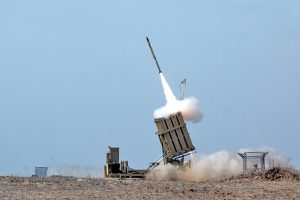
Iron Dome intercepts rockets from Gaza. Credit: Nehemia Gershuni, www.NGPhoto.biz, CC-BY-SA 4.0 via Wikimedia Commons.
The past week has seen a major escalation of conflict between Israelis and Palestinians, as confrontations and violence in Jerusalem have been followed by more than 1,000 rockets being fired indiscriminately into Israel by Gaza-based terror groups. Israel has responded with strikes targeted at Hamas in Gaza.
What happened
- Tensions and low-level violence had been rising for weeks amid several factors, including the end of Ramadan, Jerusalem Day celebrations, and the prospect of evictions from the Sheikh Jarrah neighbourhood of East Jerusalem.
- More than 150 people were injured as Palestinians clashed with Israeli police in and around the Al-Aqsa mosque in Jerusalem’s Old City on Sunday.
- Sunday night and Monday saw dozens of rockets fired on southern Israel and Jerusalem by Hamas and other terrorist groups based in Gaza, triggering the holy city’s first air raid sirens since 2014.
- Since Monday, more than 1,000 rockets have been fired by Hamas at Israel, including at Tel Aviv. At least five Israelis have died as a result.
- Israel has responded with 500 strikes against Hamas targets in Gaza, killing 53 people, of whom at least 15 were terrorist operatives.
- LFI has released a statement calling for immediate de-escalation, expressing deep distress at civilian casualties, and condemning Hamas terror attacks deliberately targeting civilians in the strongest possible terms.
Rockets over Tel Aviv
More than 1,000 rockets have so far been fired into Israel by Hamas and other terrorist groups based in the Gaza Strip. The exchanges represent the heaviest offensive between Israel and Hamas since the 2014 war. The Tel Aviv area was hit particularly hardly on Tuesday night, causing Israel to suspend flights into its international airport and cancel school on Wednesday for most children. Millions of Israelis rushed to shelter as rocket sirens blared to warn of more than 130 long-range rockets fired by terror groups in Gaza. In Rishon Lezion, near Tel Aviv, a woman was killed by a rocket strike. Eight people were injured as rockets hit the Tel Aviv suburbs of Holon and Givatayim. One rocket fell next to a bus in Holon, injuring four people including a five-year-old girl. Hamas claimed credit for the attacks on Tel Aviv and claimed they were in retaliation for Israeli strikes on a tower block in Gaza serving as accommodation for terror operatives, according to Israel’s Channel 12. Residents were warned an hour and a half prior to the strike itself, via the “roof-knocking” warning signal.
State of Emergency
A state of emergency was declared in the central Israeli city of Lod, which like other towns with large Arab-Israeli populations has seen an upsurge of rioting since the violence started.
- Gangs of Arab-Israelis torched cars and attacked synagogues and shops in Lod, in scenes described by mayor Yair Revivo as “civil war”.
- Some Jewish residents were evacuated from their homes in response to the violence.
- Tensions were sustained as Jewish extremists formed ‘defence groups’ which harassed Arabs.
- Rocket fire from Gaza also struck outside Lod, killing an Arab-Israeli man in his fifties and his teenage daughter.
- The state of emergency declared in Lod, the first use of emergency powers since 1966, saw Israeli border police brought in from the West Bank.
- Similar unrest has taken place in other cities with a large Arab-Israeli population, as well as East Jerusalem and in the West Bank.
Strikes on Gaza
Israel has responded to rocket attacks since Monday with its own strikes against targets connected to terrorist activity in Gaza, which is controlled by Hamas. Some 43 people are thought to have died in Gaza since the escalation on Monday, of whom at least 15 were connected with terrorist groups. Israeli targets have included several Hamas intelligence leaders, as well as rocket launch sites, Hamas offices and Hamas leaders’ homes. The deaths of four terrorist leaders have been confirmed so far, including Sameh Fahim Al-Malmouk, a senior commander in the Islamic Jihad’s Al-Quds Brigade, and Iyad Fathi Faik Sharir, head of Hamas’s anti-tank guided missile unit in Gaza. The Israeli military has estimated that between a quarter and a third of rockets from Gaza have fallen short and landed inside Gaza itself, risking more casualties.
Simmering tensions
Rocket fire and air strikes between Israel and Gaza represent the latest escalation of simmering tensions in the past month.
- Unrest in Jerusalem began last month, when Palestinians began demonstrating against restrictions on congregating at the Damascus Gate during Ramadan – a popular gathering place in the evening.
- Low-level confrontations took place nightly after the restrictions, which have since been lifted, were announced on 13 April. Jerusalem saw a wave of attacks on Jews, including beatings, stone throwing and street harassment.
- Of particular notoriety were videos posted on the TikTok app, including one clip of an Arab teenager slapping an ultra-orthodox Jewish man on a train.
- Following a march by Lehava, a far-right Jewish extremist group, on 23 April – at which “Death to Arabs” was chanted – clashes erupted in which more than 100 people were wounded.
- Subsequent weeks saw terror attacks and attempted terror attacks by Palestinians against Israelis.
- In a sign of things to come, there was also a flare up of violence between Israel and Gaza. More than 40 rockets were fired into Israel over the course of a weekend. Israel did not respond with counter-strikes.
Clashes in Jerusalem
Rocket fire and Israeli strikes began in the context of clashes in Jerusalem itself. More than 300 people were injured in the Old City on Sunday and Monday, focused in and around the Temple Mount/Haram al-Sharif complex, which is of religious significance to both Jews and Muslims. The annual Jerusalem Day parade, popular with Jewish nationalists, was rerouted away from the Damascus Gate and Muslim Quarter in an effort to avoid further violent confrontations. Confrontations saw Palestinians throwing rocks and launching fireworks at Israeli police from inside the complex, prompting the Israeli security forces to enter. This highly abnormal move may reflect a lack of political leadership caused by Israel’s continuing failure to form a government. Violence also erupted elsewhere, including attacks in other parts of Jerusalem. LFI has repeatedly been clear in calling for peoples of all religions to be able to pray in peace and free from violence. We strongly condemn violence against worshippers and urge Israeli security forces to show maximum restraint.
Sheikh Jarrah and Evictions
An important context to the recent tensions is the potential eviction of East Jerusalem Palestinians from homes in the Sheikh Jarrah neighbourhood.
- The Israeli Supreme Court recently postponed a decision on whether six families will be evicted from their homes, in part because of the ongoing tensions. Prime minister Benjamin Netanyahu and defence minister Benny Gantz are reported to have privately urged the postponement.
- The background to Sheikh Jarrah case is particularly complex, dating back to the sale of land to Jewish organisations in 1876, which was subsequently built upon by the Jordanian government during that country’s control of the West Bank between 1948–67. The prospect of potential evictions has prompted daily protests and confrontations.
- LFI is clear that the top priority in Sheikh Jarrah must be the de-escalation of tensions so as not to provoke violence or become obstructions to long-term peace. We echo President Biden’s calls for the Israeli government to approach the residents of Sheikh Jarrah with compassion and respect. Efforts to evict residents in East Jerusalem do not aid the vital cause of peace, reconciliation and coexistence between Israelis and Palestinians.
What next?
The Israeli military has said that it remains unclear how long the fighting would last, but estimated that a matter of “days” seemed most likely. It has been estimated that Hamas’s capacity to sustain its recent barrage of rocket attacks is likely to deplete within a week. The Biden administration yesterday called for “all parties to deescalate tensions and bring a halt to the violence”. Whether these calls will be heeded remains to be seen.


